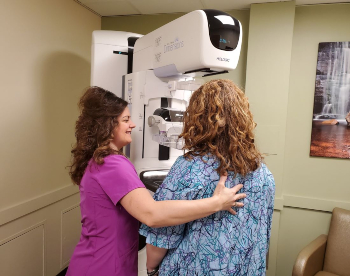3D mammograms: An updated view for breast cancer gives women greater peace of mind

Mammograms can give women a crucial head start on finding breast cancer early when treatment is often most effective. They can detect tumors that are still too small to feel and identify cancers before symptoms are obvious.
During National Breast Cancer Awareness Month, Aspirus encourages women to make prevention and early detection a top priority, and to know they have access to the most advanced screening options for greater peace of mind.
“We care deeply about the health of women in our community, which is why we emphasize the importance of regular mammograms,” said Christy Baccus, lead mammography technologist at Aspirus Keweenaw Hospital and Clinics. “Knowing your risks and catching cancer early can save your life.”
Advanced screening options close to home
All four Aspirus hospitals in the Upper Peninsula offer both 2D and 3D mammography (advanced breast tomosynthesis technology). They include Aspirus Keweenaw, Aspirus Ontonagon, Aspirus Ironwood and Aspirus Iron River hospitals. And while 2D mammography is an effective screening option for many women, 3D mammography is a more accurate exam that gives women greater peace of mind. This is especially important for women with dense breasts, or breasts that have a lot of fibrous our glandular tissues and not much fat.
A different dimension in breast x-rays
During a 3D mammogram, a woman's breast is compressed, just as it is for a standard mammogram. An x-ray machine moves over the breast, taking multiple, slice-like pictures, which allows the radiologist to review the breast tissue one layer at a time. Special computer software then creates a detailed 3D image of the breast.
“Because we can look at the breast tissue one layer at a time, it gives us even greater visibility to detect potential cancer,” Baccus said. “In many cases, 3D mammography can detect tumors that are still too tiny to feel and identify cancers before symptoms start.”
Advanced 3D mammography:
• Is clinically proven to find 41 percent more invasive cancers.
• Reduces unnecessary callbacks by 40 percent.
• Can detect breast cancers 15 months earlier than conventional mammograms.
Greater peace of mind
Women who have dense breasts are at a slightly higher risk of developing breast cancer. With 2D mammography, overlapping tissue is a leading reason why small breast cancers may be missed, and normal tissue may appear abnormal. 3D mammograms eliminate the tissue overlap effect, greatly reducing the number of women called back for further testing because of false alarms.
Get tested
The American Cancer Society recommends that women at average risk of breast cancer have yearly mammograms starting at age 45. (Women between 40 and 44 have the option to start screening with a mammogram every year.)
To learn more about your risk for breast cancer, take this quick assessment.
Pictured: Christy Baccus, lead mammography technologist at Aspirus Keweenaw, demonstrates how a 3D mammogram is performed.